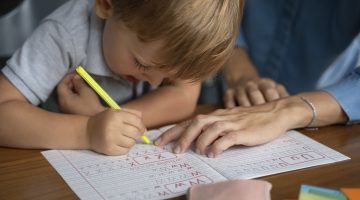How To Solve 1st-Grade Math Word Problems
Updated on April 22, 2024
Here's a word problem for you: What do sunflowers do when exposed to the sun?
Answer: They bloom!
1st grade word math problems are to math concepts what the sun is to a sunflower. They improve your child’s understanding of basic math concepts with the use of creative storytelling.
Due to its manner of presentation, tackling 1st grade math word problems can be quite tricky but with the right tutor and approach, solving it becomes a breeze.
Unlike traditional math practices that require straightforward use of formulas to derive answers, word problems involve a certain degree of creativity and logical thinking as they require the child to properly understand the meaning of the questions.
It is a great way to build relevant skills like critical and independent thinking, creativity, problem-solving, and reading fluency in kids.
Ready to help your child learn math word problems 1st grade? Then Brighterly is your best bet. Brighterly is a math learning website that incorporates gameplay to the learning process to reinforce math concepts. They offer live one-on-one classes with seasoned tutors that blend strategic teaching practices with efficient worksheets on math word problems for 1st grade, giving your first grader the edge they need.
Popular Math Problems for 1st Grade
1st-grade common core math word problems typically relate 1st grade common core math concepts to real-life situations and improves skills like addition, subtraction, division, and time telling.
Some simple math word problems 1st grade may present irrelevant information, encouraging the youngsters to carefully sift through the available data. This helps them comprehend the questions rather than finding an obvious pattern to the solutions. Here are a few examples of math 1st grade word problems for kids;
Addition Word Problems
These easy math problems 1st grade involve the addition of two or more numbers. It focuses on improving your child’s proficiency in addition.
E.g;
- Mrs Murphy bakes 8 oatmeal cookies, 6 sugar cookies, and 5 cakes. How many cookies were there?
- Mason has 5 red crayons, 9 blue crayons, and 7 yellow crayons. How many crayons does Mason have?
- Alex has 10 apples and Chris has 4 apples. How many more apples does Alex have than Chris?
Subtraction Word Problems
This involves the subtraction of two or more numbers. All differences are usually positive (negative numbers are classified information for 1st graders). Problems are usually presented in a way to encourage children to think carefully before answering.
E.g;
- Elise ordered 10 bags of flour, but the suppliers said they can only deliver 5 bags on Tuesday. The rest would be delivered on Friday. How many bags of flour would Elise have on Friday?
- Martha had 12 boxes of butter but lost 4 boxes on Wednesday due to a faulty fridge. How many boxes of butter does she have left?
Mixed Addition and Subtraction Word Problems
These problems involve the addition and subtraction of mostly single digit numbers. In order to develop the right calculation to arrive at the answers, children must carefully study mixed word problems.
E.g;
- Mary had 3 candies and her dad gave her 6 more. Then she gives 3 to her classmates. How many candies does she have left?
- You have 6 balloons and your friend has 4 balloons. How many more balloons do you have than your friend?
Time Word Problems
These word problems are typically in whole hours, and they help to reinforce time-telling skills. Children are tasked with estimating the difference between two times.
E.g;
- The second recess at school started at 2 o’clock in the afternoon, which is 2 hours after the first recess. When is the first recess?
- John had a meeting on Friday by 5 o’clock in the evening. The meeting ended by 7 o’clock in the night. How long was the meeting?
Money Word Problems
These money word problems feature coin counting. Students are given stories in which they are instructed to count their coins to figure out which person has more money, whether they have enough money to buy an item, and so on. It teaches the concept of money and quantity.
E.g;
- Abel has 50 cents, and his father gives him a quarter. How much money does Abel have?
- Juliet has 2 nickels and 2 quarters. How much money does Juliet have?
Measurement Word Problems
These problems reinforce the concept of measurement of lengths in inches or centimeters (cm). Children are tasked to compare different lengths using their skills in addition and subtraction. This helps set a foundation to learning the concept of distance.
E.g;
- Noah’s skipping rope is 7 inches long. Mark’s skipping rope is an inch shorter than Noah’s. How long is Mark’s skipping rope?
- Mary’s orange crayon is used up more than the gray crayon. The gray crayon is 3 inches longer than the orange crayon. If the orange crayon is 2 inches long, how long is the gray crayon?
- Emma has two rulers: a yellow one that is 8cm long, and a white one that is 16cm long. Which ruler is the shortest?
Fraction Word Problems
This problem requires the child to read the story and write the fractions related to the story. The fractions may either represent parts of a whole or parts of a group. This problem helps boost their skill in fractions.
E.g;
- There are 6 backpacks in the classroom. 4 are placed on the teacher’s desk, and 2 are placed on top of the toy drawer. What fraction of the backpacks are placed on the teacher’s desk?
- A classroom has 10 kids. 4 are boys, and 6 are girls.
- What fraction of the children are boys?
- What fraction of the children are girls?
Mixed Word Problems
These problems are an exciting math-cocktail of addition, length, subtraction, time, money, and fraction word problems. Combining problem types in word problems tasks children to carefully read the question and think critically to derive answers. Mixed word problems greatly boosts their logical thinking skills because they learn when and what to divide, add, or subtract.
E.g;
- There is a parking lot in front of a building. There are three rows of parking spots. There are 20 spots in each row.
- How many parking spots are there in total?
- There are 6 cars parked in the first row. How many empty parking spots are there in the first row?
- There are 8 cars parked in the second row. Are there more cars in the first row or the second row
- Emily has a bag containing 3 red pebbles, 2 white pebbles, and 5 green pebbles.
- How many pebbles are there in total?
- How many more green pebbles are there than red pebbles?
- If Emily gives away 2 green pebbles, how many pebbles would she have in total?
Conclusion
Word problems are a creative way for children to practice and boost retention of already learnt math concepts. It might sound like a problematic topic (pun intended), but with the right attitude, and a great tutor, your kids are well on their way to solving problems like a pro.
Brighterly.com is where awesome tutors use fun videos and games to teach these kinds of problems. If you’re a parent, teacher, or someone who wants to make math awesome for 1st graders, register now for Brighterly.com.










